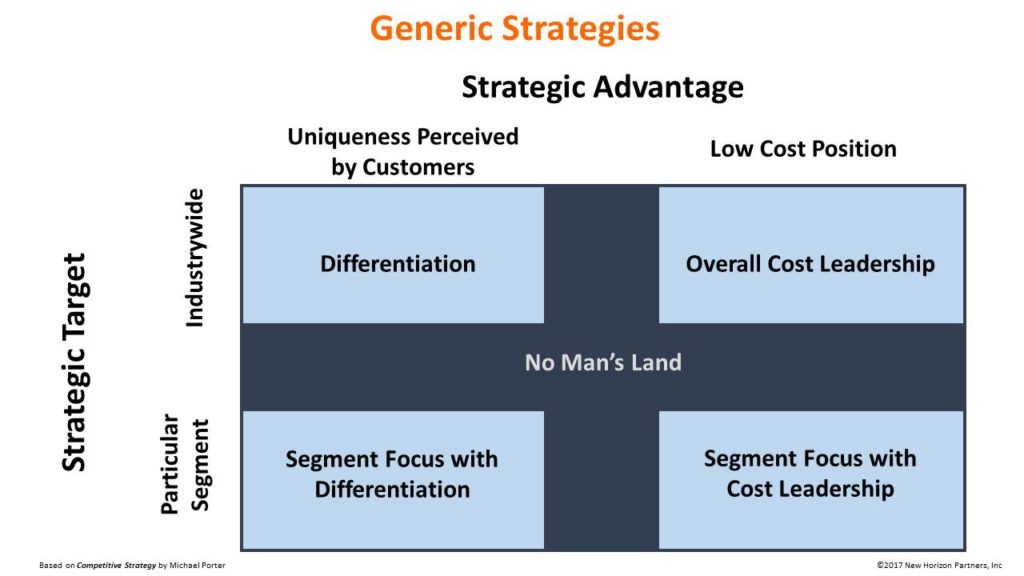The concept of generic strategies was popularized by the book “Competitive Strategy” from Michael Porter in 1980. These are not business strategies in the sense that they do not provide clarity and definition of the strategic direction of a business. Business strategy describes where and how the firm intends to compete in order to gain a competitive advantage. The purpose of a business strategy is to provide a clear guide for all decisions regarding priorities and allocation of resources. Generic strategies do not provide the clarity and definition required to guide all decisions.
What generic strategies do provide is an approach to strategy or a general description of strategic direction. These can be useful in the firm’s early stages of strategy selection or in providing a general description of competitors’ strategies. Porter listed three generic strategies – overall cost leadership, differentiation, and focus. I prefer to think of them as four general choices, as shown in the graphic. In essence, however, they all describe a method of differentiation based on either cost or features and benefits which are targeted at either the total market or the customer needs in a select segment.

The graphic is useful in demonstrating that strategy is a matter of choice. It is not possible for a single organization to choose more than one of these general directions. Firms must choose whether they will pursue a low cost position or a strategy of differentiation by offering features and benefits in either product or service that meet customer needs in a way superior to competition. Of course, the buying decision on the part of customers is based on an evaluation of the value offerings of the various competitive suppliers and evaluating each offering based on the entire list of customer needs. This means that even with a differentiation strategy, the economic value of the features and benefits must justify the price. Likewise, pursuing a low cost position still requires some fundamental offering of features and benefits. But a firm cannot compete with one foot in each camp of chasing the lowest cost position while trying to outdo competitors in features and benefits.
In a similar way, firms also sometimes struggle by attempting to be all things to all people. If the firm’s decision is to serve the entire market, the choice of features and benefits must be driven by the general requirements of customers across the industry. In some markets it is difficult to identify an industry-wide position and, by necessity, the firm must choose a segment or segments for which to target their product/service offering. Unlike the cost vs. differentiation choice, it is possible to target more than one segment for a focus strategy. However, firms should be cautious about compromising their competitive position by either mixing the features and benefits requirements of various segments or not clearly communicating with customers regarding the appropriate product/service. (Some firms address this issue by using different brands for different segments.)
A market focus with a low cost position, again, is a matter of defining the fundamental needs of a segment, which may differ from the overall market, and then pursuing the lowest cost position for serving that segment. By definition, the focus with low cost means that features and benefits are limited to the segments basic requirements.
The concept of generic strategies is an important tool for use in building a consensus within the firm regarding a general direction of business strategy. When it is understood and accepted that this decision is about choices, the leadership team can then be united in pursuing a full definition of the firm’s business strategy.
Is your business strategy firmly planted in one of the generic strategy boxes? Does your strategy have enough definition and clarity to drive the organization’s decisions?

Add your comment